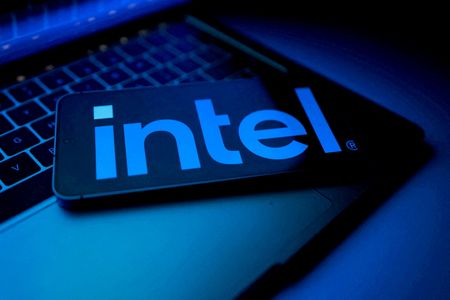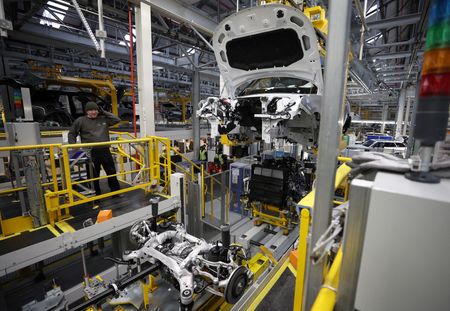By Arsheeya Bajwa, Max A. Cherney and Stephen Nellis
(Reuters) -Intel beat expectations for September-quarter profit as CEO Lip-Bu Tan’s drastic cost-cutting measures helped the chipmaker shore up its finances amid a slew of high-profile investments in the company.
Shares were up 7% in after-hours trading.
This marks the Santa Clara, California-based company’s first earnings announcement after multibillion-dollar investments from Nvidia and Japan’s SoftBank as well as an unprecedented U.S. government stake, with investors anticipating a major cash boost.
Intel received the SoftBank money in the third quarter but has not yet received Nvidia’s cash, finance chief Dave Zinsner said in an interview with Reuters.
The investments are expected to be a major lifeline for Intel, which has been struggling to maintain its dominance in the PC and server central processing unit markets as it competes with Advanced Micro Devices, while repeated attempts to break into the AI chip market commanded by Nvidia have not produced results.
After its share price dropped about 60% last year due to these concerns, Intel stock has risen nearly 90% so far in 2025 thanks to the new investments in the company, helping it outperform the stock of artificial-intelligence chip leader and Wall Street darling Nvidia.
“Shares popped after-hours based on better-than-feared guidance ex-Altera, visible cost and gross margin progress, AI-PC buzz, and $15B of fresh strategic funding that shores the balance sheet,” said Michael Schulman, chief investment officer at Running Point Capital.
Intel acquired Altera in 2015 for $16.7 billion but sold a 51% stake in the programmable chip designer to Silver Lake in September.
Nvidia said last month it would invest $5 billion in Intel, giving it a stake of about 4% after new shares are issued. In August, Intel secured $2 billion from SoftBank.
After U.S. President Donald Trump called for CEO Tan’s resignation over China ties, a hastily arranged Washington meeting produced an unusual deal involving the U.S. government taking a 10% stake for $8.9 billion.
On a conference call with investors, Tan said that a newly formed central engineering group will streamline Intel’s work on its own chip designs and will also offer custom-designed chips for external customers, a business where it will compete against Broadcom and Marvell Technologies. Those two companies are both helping customers such as Alphabet’s Google and Amazon make their AI chips.
Demand for Intel’s chips was strong enough during the third quarter that the company is tight on supply, CFO Zinsner said. One of the factors is that data center operators have realized that they need to upgrade the central processing unit in order to keep pace with the advanced AI chips, he said. Upgrading the CPU gives power and performance advantages that help build and run AI applications.
“We’re under-shipping demand at this point, which I guess is a high-class problem,” Zinsner said.
During the conference call, Zinsner said that Intel’s yields – a measure of how many of the chips it makes come out functioning well – for its 18A manufacturing process “are not where we need them to be in order to drive the appropriate level of margins.” Zinsner said yields would likely not hit “an industry-acceptable level” until 2027.
Reuters reported in August that Intel is struggling with yields on its 18A manufacturing technology.
For the September quarter, it recorded adjusted gross margins of 40%, beating estimates of 35.7%, while adjusted profit of 23 cents per share also outperformed expectations of a profit of 1 cent per share, according to data compiled by LSEG.
The company will end the year with a workforce that is over one-fifth smaller than last year, it had said in July, while Tan has significantly pared back the expensive manufacturing ambitions of his ousted predecessor, Pat Gelsinger.
Tan has aggressively cut costs and divested assets, after Gelsinger’s ambitions of turning Intel into a contract manufacturer of chips that would compete against Taiwan’s TSMC led to the company in 2024 recording its first annual loss since 1986.
Intel forecast current-quarter revenue between $12.8 billion and $13.8 billion, with a midpoint of $13.3 billion, compared with analysts’ average estimate of $13.37 billion. Zinsner said that Intel plans capital expenditures of $27 billion in 2025 versus $17 billion in 2024.
(Reporting by Arsheeya Bajwa in Bengaluru and Max A. Cherney and Stephen Nellis in San Francisco; Additional reporting by Aditya Soni in Bengaluru; Editing by Sayantani Ghosh and Matthew Lewis)











